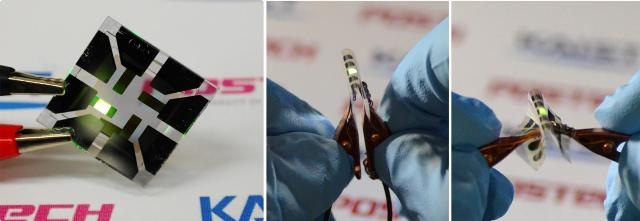Jun 6 2016
Recently, flexible organic light-emitting diodes (OLEDs) manufactured on a plastic substrate have gained much publicity for their application in advanced displays, which can be rolled or bent while in operating mode. In the future, it would probably be possible to roll up thin and lightweight computer just like a sheet of paper.
 This picture shows an OLED with the composite structure of TiO2/graphene/conducting polymer electrode in operation. The OLED exhibits 40.8% of ultrahigh external quantum efficiency (EQE) and 160.3 lm/W of power efficiency. The device prepared on a plastic substrate shown in the right remains intact and operates well even after 1,000 bending cycles at a radius of curvature as small as 2.3 mm. (Photo Credit: KAIST).
This picture shows an OLED with the composite structure of TiO2/graphene/conducting polymer electrode in operation. The OLED exhibits 40.8% of ultrahigh external quantum efficiency (EQE) and 160.3 lm/W of power efficiency. The device prepared on a plastic substrate shown in the right remains intact and operates well even after 1,000 bending cycles at a radius of curvature as small as 2.3 mm. (Photo Credit: KAIST).
A team of Korean researchers headed by Professor Seunghyup Yoo from the School of Electrical Engineering, KAIST and Professor Tae-Woo Lee from the Department of Materials Science and Engineering, Pohang University of Science and Technology (POSTECH) has created extremely flexible OLEDs with exceptional efficiency by utilizing graphene as a transparent electrode (TE). The TE is sandwiched between conducting polymer layers and titanium dioxide (TiO2). The results of their efforts are available online in the journal Nature Communications (June 2, 2016 issue).
OLEDs are stacked in many ultra-thin layers on foil, glass, or plastic substrates, wherein several layers of organic compounds are placed in between two electrodes – anode and cathode. Electrons from the cathode and positive charge holes in the anode come together and assemble in the emissive layer when voltage is applied through the electrodes. OLEDs transmit light as an electron reintegrates with a positive hole, emitting energy in the form of a photon. One of the electrodes in OLEDs is typically transparent, and based upon which electrode is transparent, OLEDs emission could be either from the bottom or the top.
In traditional bottom-emission OLEDs, an anode is transparent so that the emitted photons can exit the device via its substrate. Indium-tin-oxide (ITO) is usually used as a transparent anode due to its high transparency, proven manufacturing process, and low sheet resistance. However, ITO could possibly be costly. Furthermore, it could be brittle, as well as susceptible to forming cracks caused due to bending. Graphene is a 2D thin layer of carbon atoms that is strongly bonded together in a hexagonal honeycomb lattice. This material has lately emerged as a substitute to ITO.
Graphene has exceptional physical, electrical, and chemical properties. Its atomic thinness offers a high degree of transparency and flexibility, thereby making it a suitable material for TEs. However, the efficiency of graphene-based OLEDs so far reported, only possessed the same level of ITO-based OLEDs.
The Korean research team along with Professors Sung-Yool Choi (Electrical Engineering) and Taek-Soo Kim (Mechanical Engineering) of KAIST and their students, came up with a solution. They proposed a completely new device structure that can increase the efficiency of graphene-based OLEDs. They fabricated a transparent anode in a composite structure, wherein a TiO2 layer possessed a hole-injection layer (HIL) and a high refractive index (high-n) of conducting polymers with a low refractive index (low-n) sandwich graphene electrodes. This is an optical design capable of inducing a synergistic integration between the high-n and low-n layers to optimize the effective reflectance of TEs. Consequently, the optimization of the optical cavity resonance is greatly increased.
The optical cavity resonance is linked to the enhancement of color gamut and in OLEDs. Another benefit is that loss from surface plasmon polariton (SPP) is decreased because low-n conducting polymers are present. This loss from SPP used to be the reason for weak photon emissions in OLEDs.
Under this method, graphene-based OLEDs reveal 160.3lm/W of power efficiency and 40.8% of ultrahigh external quantum efficiency (EQE), which is unparalleled in those using graphene as a TE. Moreover, these devices stay intact and function well even after exceeding 1,000 bending cycles at a radius of curvature measuring just 2.3mm. This is an outstanding outcome for OLEDs containing oxide layers such as TiO2 as oxides are characteristically brittle and inclined to bending-induced cracks even at a comparatively low strain. The Korean researchers discovered that TiO2 possessed a crack-deflection toughening mechanism that helps to prevent bending-induced cracks from being formed easily.
What's unique and advanced about this technology, compared with previous graphene-based OLEDs, is the synergistic collaboration of high- and low-index layers that enables optical management of both resonance effect and SPP loss, leading to significant enhancement in efficiency, all with little compromise in flexibility. Our work was the achievement of collaborative research, transcending the boundaries of different fields, through which we have often found meaningful breakthroughs.
Professor Yoo
We expect that our technology will pave the way to develop an OLED light source for highly flexible and wearable displays, or flexible sensors that can be attached to the human body for health monitoring, for instance.
Professor Lee